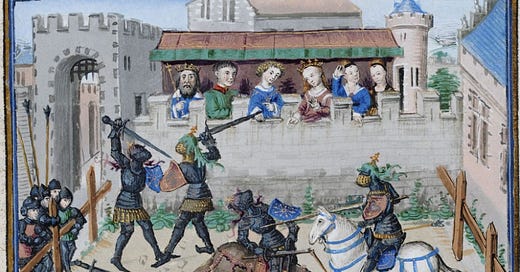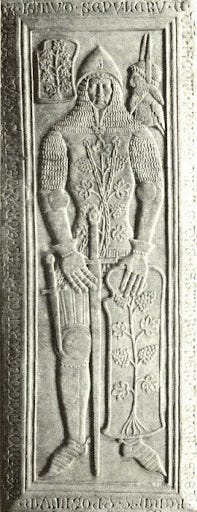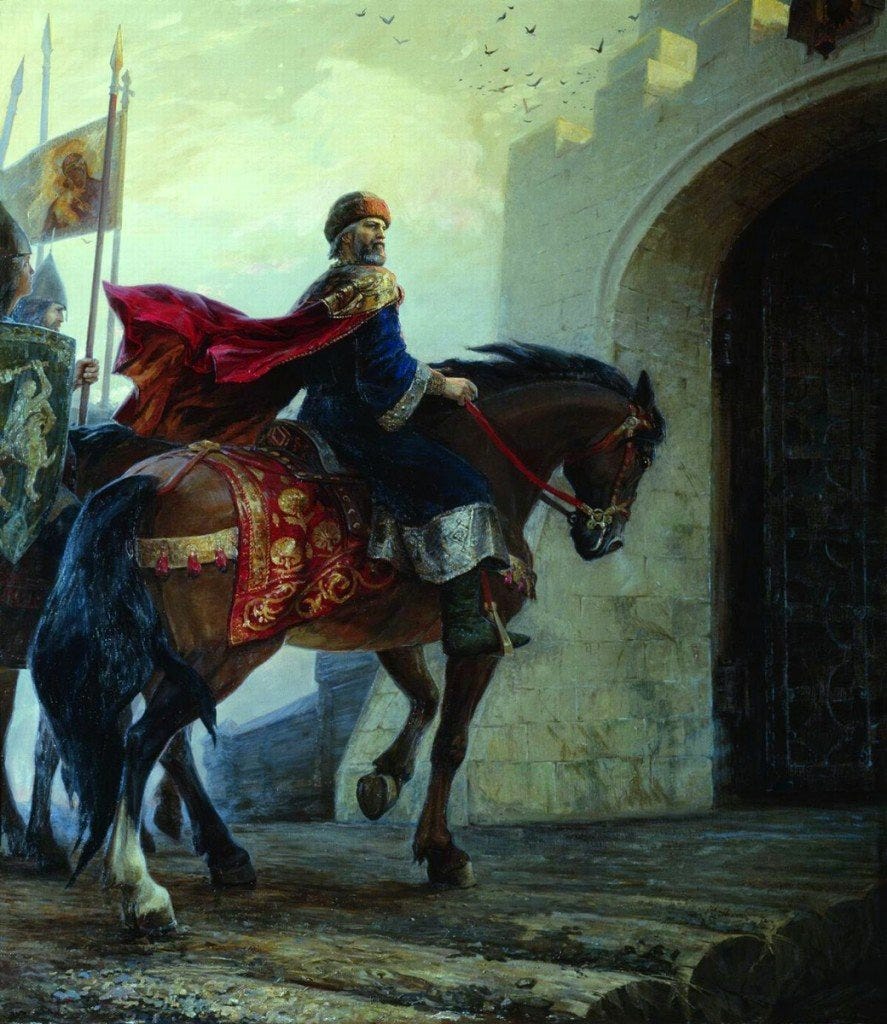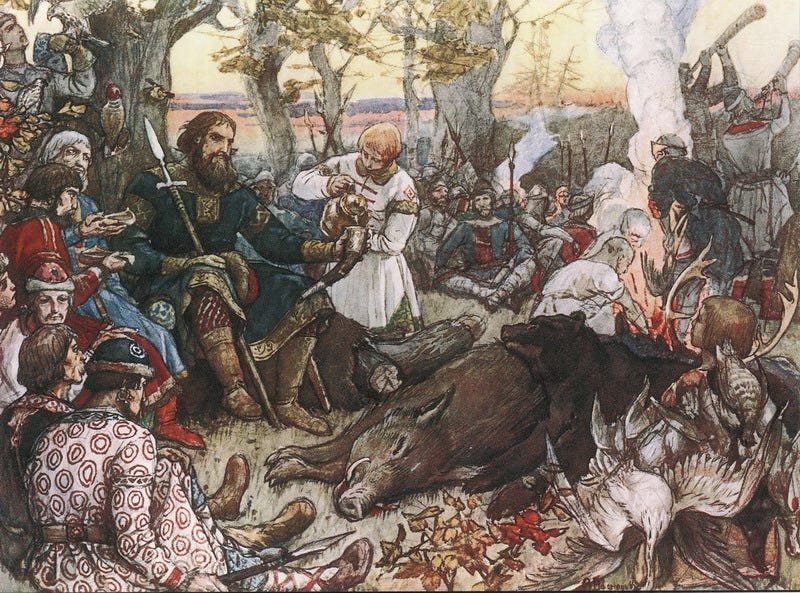Hunting and Tournaments as Reflections of Valor of Medieval Knights and Russian Princes
Once upon a time, in the turbulent Middle Ages, two realms stood at the crossroads of history: the diverse kingdoms of Europe and the vast principalities of Russia.
The knights of Europe and the princes of Russia donned their armor not merely as a means of protection but as symbols of identity, culture, and heritage.
(photos are from different internet sources mentioned in the “What to Read” section)
The Knights of Europe
In the early Middle Ages, around the 5th to 11th centuries, European knights stood tall in the shadows of their colossal wooden shields, clad in hauberks of interlinked metal rings that glimmered under the sun. They wielded swords, axes, and spears, their spangenhelms—a distinctive, segmented helmet—guarding heads filled with honor and ambition. This was when valor on the battlefield was often measured in the clang of metal and the cries of warriors.
As the 11th century rolled in, the armor of these knights evolved. Mail armor remained a constant companion, yet innovation breathed new life into their defensive gear. Great helms emerged, encasing their faces and adding an aura of mystery to the once-unmasked figures who charged into battle. With the arrival of heraldry, knights began to paint their shields with symbols of their lineage, turning the chaotic clash of war into a colorful tapestry of identity and allegiance.
By the 14th and 15th centuries, European warfare transformed dramatically with the advent of full plate armor. Knights became almost like walking fortresses, encased in glimmering metal that reflected the sun's rays and struck awe into the hearts of their enemies. Helmets like the bascinet, with visors that shielded their faces, became commonplace. Yet, with such formidable protection came the challenge of overcoming it; now, polearms and war hammers became the weapons of choice for those seeking to breach these armored giants.
The Princes of Russia
Meanwhile, a different story of armor and warfare unfolded across the vast expanses of the Russian principalities. Influenced by the grandeur of the Byzantine Empire and the fierce nomadic tribes of the East, Russian princes founded their legacy of battle attire. In their early confrontations, similar to their European counterparts, they wore mail armor, complemented by distinct regional variations that spoke of their rich cultural tapestry.
Conical and rounded helmets adorned their heads, often featuring mail aventails to protect their necks—practical innovations necessary for survival in their complex warfare environment. Just as the knights had shields, these princes wielded robust shields, spears, bows, and elegantly crafted swords, ready to defend their lands.
As centuries progressed, the armor of Russian warriors absorbed influences from the East, adopting lamellar armor—crafted from small, overlapping plates that offered flexibility and mobility deemed essential on the diverse battlefields they faced. The contact with the Mongols introduced different styles and techniques, prompting Russian armor to evolve continuously. Unlike their European counterparts, who gravitated toward the heavy, fully encased plate armor, the Russian princes emphasized adaptability, preparing themselves for their expansive territory's vast array of challenges.
In the heart of late 14th-century Italy, amidst the echo of clashing swords and the cheers of spectators, stood the castle owned by Sir Giacotto Provana, a knight of notable prowess and noble lineage. His heart swelled with pride for his martial achievements and social status as he considered the legacy he wished to leave behind.
A Willful Legacy
In a move that would mark the bridging of life and death, Giacotto consciously chose to commission his effigy, an act rarely undertaken by the living. This monumental decision would become a symbol of his identity as a knight and the way he wanted future generations to remember him.
As skilled artisans crafted his likeness, they adorned the effigy with intricate decorations—a marvelous tapestry of grapevines and floral patterns that danced across the fabric of the surcoat. This flamboyant adornment was impractical in the chaos of genuine battle, where protection mattered most. Yet, this elaborate display was welcomed and celebrated in the tournaments, where spectacle and social standing intertwined with combat skills.
Giacotto’s visage was sculpted in tournament armor, a choice that spoke volumes about his character and priorities. Unlike the heavy plate armor worn in actual battle, this lighter design was tailored for mobility and agility, fitting for the jousts he cherished. The heraldic crest emblazoned proudly across his chest proclaimed his noble lineage with the pride befitting a knight. In these tournaments, knights showcased their heraldry not only for glory but also to create a visual representation of their status among peers.
Tournament Valor
As the effigy took form, it encapsulated more than just Giacotto’s martial reputation; it reflected the cultural significance of tournaments in his life. These events were moments of prestige, camaraderie, and rivalry, providing opportunities for knights like Giacotto to establish their social standing.
However, shadows lingered over this glossy exterior. Whispers among scholars suggested that self-commissioned effigies might indicate a sense of foreboding—perhaps Giacotto, in his keen understanding of the dangers that accompanied tournament jousting, sensed a likelihood of an early death. This belief, while speculative, added a poignant layer to the effigy’s meaning.
A Life Defined by Choice
The effigy's unusual design, depicting Giacotto in a seemingly propped-up position, hinted at a moment between triumph and calamity. Unlike the traditional recumbent position of most effigies of the time, his pose could symbolize the fleeting moments of a valiant knight who, perhaps, fell in honor during a tournament. A closer analysis revealed his facial expression—a subtle distress that beckoned viewers to question the circumstances encapsulated in stone.
This complexity manifested Giacotto’s desire to assert his identity boldly while also addressing the inevitable uncertain future that comes with the life of a knight. His heirs' involvement in creating the effigy underscored familial ties and the importance of lineage, cementing his identity within his family's history and at court.
Legacy and Interpretation
While representing the valorous knight he was, Giacotto Provana's effigy also served as an enduring reminder of his choices regarding how he wished to be remembered. Did he want his legacy forever tied to tournament prowess, or was it a conscious acknowledgment of his mortality, standing as a tribute to the honor in which he sought to die?
The possibility that Giacotto may have intended this effigy to signal a tournament-related death resonates strongly with those who understand the perils that knights faced. However, it could equally be seen as a bold statement of pride. In the grand hall of his castle, where echoes of laughter and the creaking of armor filled the air, Giacotto’s self-commissioned monument allowed him to preside over his narrative, blending the lines between life, legacy, and memory.
In examining the effigy of Giacotto Provana, we unearth a rich tapestry of history that paints a picture of a man who was not only a warrior but a deliberate architect of his legacy. As we stand before his carved likeness, we glimpse the ambition, valor, and perhaps the foreboding of a life lived in the arena of challenges. His choices regarding his monument invite us to ponder the deeper meanings behind the rites of memory and the echoes of the past that continue to shape our understanding of identity in the echoes of time.
In the annals of history, Vladimir Monomakh's feats stand out as a testament to the courage and skills of a prince who lived on the fringes of the wild, roaming the great expanses of Ancient Russia. His vivid stories of daring exploits paint a picture of a warrior’s life inseparable from the trials of nature.
The Valor of Hunting
"And this is what I did in Chernigov: I tied up ten and twenty wild horses with my own hands in the wilderness, live horses, and the fact that, riding across the plain, I caught the same wild horses with my own hands. Two bulls threw me with their horns together with the horse, one deer butted me, and of two elks, one trampled me with its feet, the other butted me with its horns; a boar tore off the sword on my thigh, a bear bit my saddle cloth near the knee, a fierce beast jumped on my hips and knocked the horse over with me. And God kept me unharmed. And I fell from my horse many times, I broke my head twice, and I damaged my arms and legs ... "
In his own words, Monomakh recounted the thrill of harnessing wild horses, battling fierce bulls, dodging the horns of enraged elks, and narrowly escaping the grips of bears and boars. His accounts reveal not just a physical struggle but a display of strength, skill, and courage comparable to that showcased in the tournaments of knights in Western Europe.
Just as knights donned their armor for jousts that tested their prowess, Monomakh’s hunting was a vigorous assertion of his valor—a rite of passage where he faced nature’s fiercest beasts. The exhilaration of the chase demonstrated his physical agility and skill in wielding weapons, echoing the knightly traditions where combat skill was honed through tournaments.
Preparation for Battle
Hunting demonstrated prowess and was crucial training for warfare. In the dense forests of Ancient Rus, the ability to track, ambush, and bring down large animals prepared young princes and their retinues for the strategies and tactics needed on the battlefield. Hunting's tumultuous nature, with its unpredictability akin to the chaos of battle, mirrored the combative spirit present in knightly tournaments.
As Monomakh illustrated, every encounter brought danger—serious injuries were shared as he battled beast after beast. This reflects the inherent training for risk and resilience, which fosters the qualities necessary for leadership in war.
Social Status and Authority
Beyond personal valor, hunting was a crucial element of the prince’s image and authority. Just as a successful tournament champion earned accolades and prestige, so did a victorious hunt elevate Monomakh’s standing among his people. The successful capture of formidable beasts affirmed his leadership qualities and instilled respect in those around him.
In this way, both pursuits—the hunting in Russo and the tournaments of Western knights—acted as arenas for establishing and reaffirming social hierarchies. They were not merely contests of skill but crucial spectacles that shaped public perception and cemented individual reputations.
Distinctive Differences
Despite the parallels, significant differences arose from their respective cultural backgrounds and environments. Monomakh’s hunts were fraught with natural dangers, devoid of the structured rules that governed knightly tournaments. The rawness of wrestling with living beasts far from the safety of a jousting list marked these outings as an actual test of survival, steeped in authentic risk.
Moreover, the geographical realities of Ancient Rus’—with its sprawling forests teeming with wild animals—contrast sharply with the more regulated environment of Western Europe, where tournaments became a formalized spectacle reflective of chivalric ideals.
Culturally, hunting in Slavic traditions was not merely entertainment. It intertwined with the community's deep-rooted beliefs and rituals. Meanwhile, Western tournaments evolved from knightly customs centered on honor, competition, and social display.
Complementary Traditions
Ultimately, Vladimir Monomakh's exploits showcase the complex interplay between hunting and tournament traditions in their respective societies. Both avenues offered individuals a means to demonstrate valor, prepare for warfare, and reinforce social status. Yet, geographical, cultural, and environmental differences create a rich tapestry of historical practices.
Thus, while hunting in Ancient Rus’ served functions parallel to the knightly tournaments of Europe, it remained distinctly influenced by local traditions and survival realities. These unique elements reveal not just the life of a prince but also a deeper understanding of what it meant to be a warrior in the tapestry of history.
What to read:
https://www.metmuseum.org/essays/arms-and-armor-in-medieval-europe
https://www.filodiritto.com/uno-stemma-inquartato-la-famiglia-provana
https://www.battlemerchant.com/en/blog/shields-in-the-middle-ages-protection-symbol-and-tactic#:~:text=Wood%20formed%20the%20backbone%20of,most%20weapons%20of%20the%20time.
https://www.metmuseum.org/essays/fashion-in-european-armor-1000-1300
https://www.mylineage.com/blog-coat-of-arms-origin/#:~:text=The%20medieval%20era%20was%20the,to%20identify%20themselves%20to%20their
https://en.wikipedia.org/wiki/Bascinet#:~:text=The%20bascinet%2C%20both%20with%20and,half%20of%20the%2015th%20century%2C
https://www.britannica.com/sports/tournament-medieval-military-games#:~:text=tournament%2C%20series%20of%20military%20exercises,fought%20one%20another%20to%20display
https://www.english-heritage.org.uk/visit/inspire-me/brief-history-of-knights-tournaments/
ARE YOU INTERESTED IN OTHER STORIES?
They are here: https://amzn.to/42zESYu
P.S.
“Either My Son or Nobody” is now available in a third edition in digital formats.
“Those Eyes Behind The Glass Door” is available, too.
You can purchase them here for €5.00
I do not have paperbacks.
Please email me at liudmila.books@gmail.com to request a special price for my stories and specify your preferred file format. I typically respond within one working day.
I can add dedication on request.











